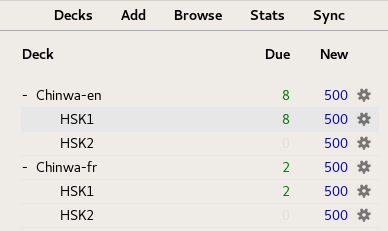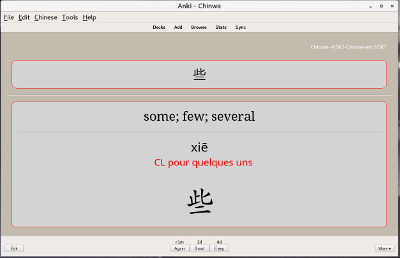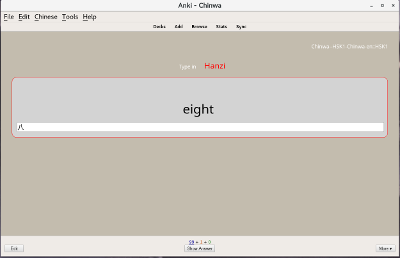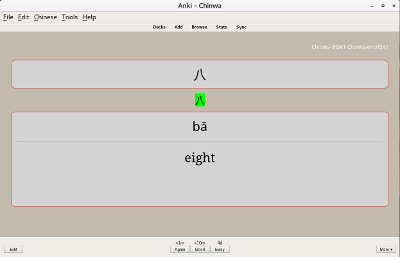Chinwa was a website with some Chinese language learning resources: HSK lists in French and English, and some grammar points explained.
I built learning lists with audio from these resources and Anki decks.
|
|
6 anni fa | |
|---|---|---|
| Anki | 6 anni fa | |
| Images | 6 anni fa | |
| Listes-mots-formatés | 6 anni fa | |
| Programmes | 6 anni fa | |
| .gitignore | 6 anni fa | |
| README.md | 6 anni fa |
README.md
Chinwa Chinese language resources
Progression:
- HSK 1 : 100% (with audio)
- HSK 2 : 100% (with audio)
- HSK 3 : List: 100%, no audio
- HSK 4 : List: 100%, no audio
- HSK 5 : List: 100%, no audio
Introduction
Chinwa was a website with some Chinese language learning resources: HSK lists in French and English, and some grammar points explained. The website is no longer online.
I earlier got some of their stuff and built learning lists with sound in different format: xml, json and csv.
These lists can easily be imported in Anki, or another program.
I made an Anki deck with sound: most of the sounds come from the Shtooka project Shtooka project or on my website which maintains a copy of it (I added some missing parts) Yojik Website.
The missing sounds were created by Text To Speech: I tried many flavors of the system and ended using the sounds produced by Google translate. I wrote some script to automaticely download the sounds.
The lists
I extracted the lists from the web pages. I built csv (comma separated value) files from the extraction:
Here is an example:
爱 ài aimer, affection, apprécier
I added some fields: traditional writing, origin, sounds, so I got this:
爱 愛 ài aimer / affection / apprécier love HSK1
[sound:cmn-1cd08e6e.ogg]Chinwa 29233
The transformation program is written in nodejs/javascript: Ididn't know well the language at thi time, so, I decided to deep a bit with real problem solving.
Th program generates 2 other files:
a JSON file with the same content as the .csv files.
{
"hanzi": "爱 ", "traditional": "愛 ", "pinyin": "ài", "translation": "aimer / affection / apprécier ", "classifier": "", "lesson": "HSK1", "sound": "`[sound:cmn-2d9d12c4.ogg]`", "origin": "Chinwa"}
a XML file, with the same content.
<hanzi>爱 </hanzi> <traditional>愛 </traditional> <pinyin>ài</pinyin> <translation>aimer / affection / apprécier </translation> <classifier/> <lesson>HSK1</lesson> <sound>[sound:cmn-2d9d12c4.ogg]</sound> <origin>Chinwa</origin>
The Anki decks
The Anki decks are created by importing the .csv files.
I created different notes, to exercise different parts of the language.
There are 7 different ways to learn:
Normal
This is like the normal use of Anki, with the Hanzi presented (recto) and the English or French translation presented on the verso face. There is sound associated.
Inversé
Exactly the same than Norma deck, but in the other way: English/French displayed, Chinese guessing.
Sound
You'll her the sound, and have to guess the translation (English or French.)
Saisie-Hanzi
The English/French translation is displayed, and you have to type the Hanzi correspondance.
Saisie-Pinyin
The English/French translation is displayed, and you have to type the Pinyin correspondance.
Son-Saisie-Hanzi
You'll hear the sound (Chinese) and will have to type the corresponding Hanzi.
Son-Saisie-Pinyin
You'll hear the sound (Chinese) and will have to type the corresponding Pinyin.
Traditional
This is like the Normal deck, but with traditional writing.





